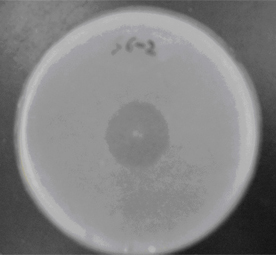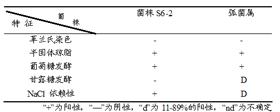Ocean low-temperature dextranase, enzyme producing method and strain S6-2 produced therefrom
A kind of dextranase, low temperature technology, applied in the field of marine low temperature dextranase and enzyme production and production bacteria S6-2
- Summary
- Abstract
- Description
- Claims
- Application Information
AI Technical Summary
Problems solved by technology
Method used
Image
Examples
Embodiment 1
[0084] Example 1. A Vibrio S6-2 ( Vibrio sp. S6-2) CGMCC N0.4011. The strain has the following characteristics: the strain is a Gram-negative rod-shaped bacterium without spores, and its size is about 1.31-1.58 μm × 0.53-0.79 μm; the colony characteristics on the solid medium containing dextran: the diameter of the colony is 2mm-5mm, round Shape, milky white, moist, transparent, add 95% ethanol after the colony grows, freeze for 3~4 hours, a transparent circle appears around the colony; the strain V-P test is negative, MR test is positive, cannot grow without sodium chloride, can liquefy gelatin, and has movement Ability; can use sucrose, fructose, but can not use lactose, galactose, mannose, xylitol, cellobiose, arabinose, melibiose, sorbitol. The growth characteristics of Vibrio S6-2 are: the growth temperature range of the strain is 4-37°C, the growth pH range is 6-11; the growth NaCl concentration range is 0.5%-10%; the optimum growth temperature of the strain is 25°C ;...
Embodiment 2
[0085] Example 2. A method for Vibrio S6-2 CGMCC No.4011 producing low-temperature dextranase as described in Example 1, the steps are as follows: Vibrio S6-2 ( vibrio sp. S6-2) strains were inoculated into 2216E medium, the rotation speed was 180r / min, the liquid volume was 20%, and the seed liquid was obtained after culturing for 12 hours; min, cultured at 25°C for 24h, centrifuged at 10000r / min for 5min, and the supernatant was prepared by ammonium sulfate, DEAE-sepharose Flat Flow and Sephacryl S-200 methods to prepare low-temperature dextranase.
Embodiment 3
[0086] Example 3. A low-temperature dextranase produced by the method described in Example 2, the low-temperature dextranase has the following characteristics: the properties of the low-temperature dextranase are: the optimum action temperature of the dextranase is 20°C, and it is incubated at 60°C for 2h Afterwards, the enzyme still has more than 50% activity; dextranase is stable in the range of pH6.0-10.0, Hg 2+ , Pb 2+ , Mn 2+ , Mg 2+ , Li 2+ 、Co 3+ 、Cu 2+ , Zn 2+ have varying degrees of inhibition on enzymes; Al 3+ The enzyme can be activated; SDS, urea, DTT and NBS can inhibit the enzyme.
PUM
 Login to View More
Login to View More Abstract
Description
Claims
Application Information
 Login to View More
Login to View More - R&D
- Intellectual Property
- Life Sciences
- Materials
- Tech Scout
- Unparalleled Data Quality
- Higher Quality Content
- 60% Fewer Hallucinations
Browse by: Latest US Patents, China's latest patents, Technical Efficacy Thesaurus, Application Domain, Technology Topic, Popular Technical Reports.
© 2025 PatSnap. All rights reserved.Legal|Privacy policy|Modern Slavery Act Transparency Statement|Sitemap|About US| Contact US: help@patsnap.com



